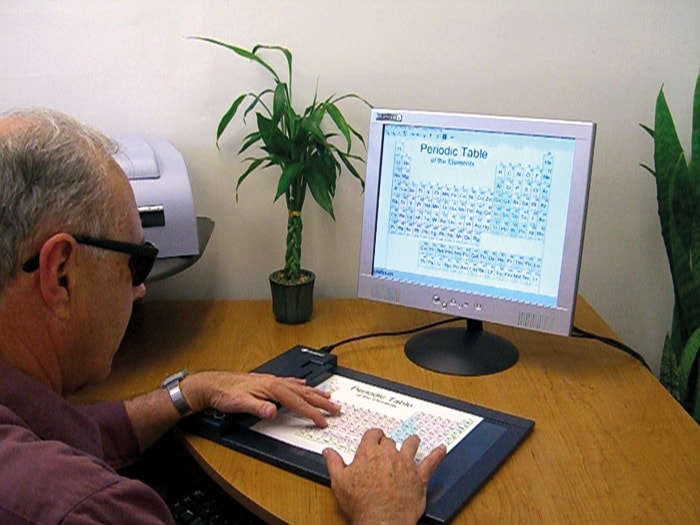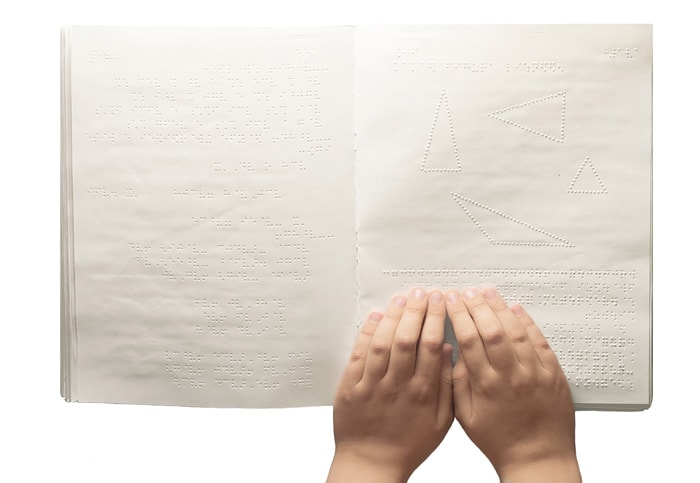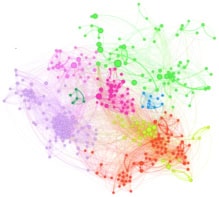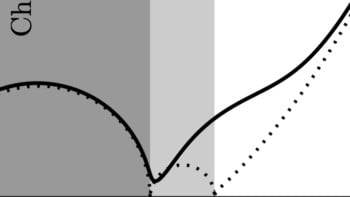Modern technologies and educational policies aim to make physics fully accessible to the blind. But just how easy is it for the sightless, asks Jon Cartwright
Every age has its great teachers, and in the early 18th century one of them was Nicholas Saunderson. From 1711 until his death in 1739 at the age of 57, Saunderson was the Lucasian Chair of Mathematics at the University of Cambridge in the UK – a post held just a few years previously by Isaac Newton, and in recent times by Stephen Hawking. He would lecture to packed halls for at least eight hours a day on subjects ranging from mechanics and hydrostatics, to optics and astronomy. He was said to have a tremendous feel for his subject. Literally, as it turns out: he was blind.
Times were certainly tough 300 years ago for the sightless. Having lost his eyes to smallpox as a baby, Saunderson is said to have taught himself to read by tracing out the letters on gravestones. Yet he was luckier with his situation than most. Saunderson’s father and his friends supplemented his school education by reading to him at length, and in his teens he made a learned acquaintance who brought him up to speed with the latest developments in mathematics. His ultimate accession to Lucasian professor was doubly impressive, for the university’s decision went against the wishes of Newton himself – and there are not many known instances of that.
But is it any easier to be a blind physicist today? Inclusive education policies, leaps in technology and a better awareness of the needs of the disabled all suggest a positive answer, yet blind physicists seem to be few and far between. Perhaps the most famous living example is the US astronomer Kent Cullers, whose involvement in NASA’s Search for Extra-terrestrial Intelligence (SETI) programme was fictionalized in the 1997 blockbuster Contact. “We’re in a sighted person’s world,” says Aqil Sajjad, a blind theoretical physicist who lives in Boston, US.
Sajjad knows how determined a blind person must be to have a career in science. Aged 10, he was playing with his cousins one day at home in Islamabad, Pakistan, when a large green blob entered his vision on one side. Doctors diagnosed it as a detached retina, and before long he was blind in that eye. Six years later, his sight left the other eye too – and with it, his dream of being a scientist. “The education authorities back in Pakistan basically told me that I couldn’t be a scientist,” he recalls.

To avoid missing out on education altogether, Sajjad switched his studies to the arts and humanities, and went to business school. Like Saunderson he benefited from having materials read to him, in this case by his mother, who had a maths degree herself. But to pursue his passion for science he applied to universities in the US, where he anticipated more encouraging attitudes. From several offers, he chose Oregon State University in Corvallis.
Hidden problems
Being blind poses all sorts of challenges in day-to-day life, but one additional difficulty is finding learning materials that are either audible, as in text-to-speech software, or tactile, as in braille. A particular problem with physics, however, is its fundamental reliance on maths, which doesn’t always convert easily to these non-visual media. Within English-speaking countries there are at least two versions of mathematical braille, which means that students have to learn the version suited to where most of their publications come from; and even then, the vast majority of publications are not available in braille in the first place, and can take months or years to translate. Meanwhile, traditional text-to-speech software – though rapidly improving – still often garbles mathematical formulae.
At Oregon State University, Sajjad rejected mathematical braille, which he says was “too slow”, and so staff instead provided specialist text-to-speech software called Triangle. Based on a simplified version of LaTeX – the widely used code to prepare documents containing mathematical formulae for publication – Triangle can read scientific learning materials out loud in a sequential manner, equations included. If an equation contains a fraction, for example, the software alerts the user to a nominator before reading through it, and then tells the user that the nominator is over before moving on to the denominator.
After his degree, Sajjad did a PhD in particle physics phenomenology at Harvard University in Cambridge, US, where he was given a graduate student to oversee the accessibility of his materials. The student wrote a new program to convert LaTeX documents directly into Triangle format, thereby making available a huge portion of the scientific literature: many of the papers on the popular arXiv server exist in LaTeX format, for example. Technical books are often also prepared in LaTeX format, although Sajjad was disappointed to find that the publishers were unwilling to share those versions, for protection of copyright.
His PhD complete, Sajjad is now in the enviable position of deciding which area of theoretical physics he wants to pursue next. He admits that he was wise to take his undergraduate studies at Oregon State University, knowing that it had already primed itself for blind students thanks to earlier work by John Gardner, a leading materials scientist at the institution. In 1988, at the age of 48, Gardner had surgery to correct vision that had long been deteriorating due to glaucoma. Instead of improving his sight, however, the surgery suddenly stole it away. “The doctor told me I needed this tiny operation to keep me from going slowly blind. And it did,” Gardner jokes now, nearly 30 years later.
Gardner was “pretty sick” for several months after his operation, he says, yet he couldn’t afford to be absent long. “I had a large research group to manage. From the hospital bed, I was fighting with the NSF [US National Science Foundation] to keep funding for a postdoc.” His established position in academia was an advantage: colleagues were almost all supportive, while the university itself “bent over backwards” to help because of the grant money he brought in. But returning to his actual research was hard, as much of it involved fitting theoretical models to experimental data. “That was the difficult bit. Everything else had a solution, but that didn’t, except using the eyes of other people.”

The magic touch
Before long, Gardner found himself brainstorming ways to overcome the hurdles he faced. Triangle – the mathematics-to-speech software to which Sajjad would turn years later – was in fact one of his inventions. But the real test was how to deal with graphs, diagrams and other graphics. In the early 1990s studies of accessibility had identified “audio-tactile” as an effective way of presenting graphical information to the blind. The method involves an embossed hard copy of a graphic that is linked to an audio system, which has been taught (e.g. by a sighted colleague) to describe different parts of the graphic when those parts are touched. In the dark, an embossed bicycle might feel like a bunch of random squiggles, for example, but it quickly comes to light with touch-sensitive audio descriptions of “wheel”, “crossbar” and “pedal”. “I knew audio-tactile was the right method,” says Gardner, “but there was no software or hardware to support it.”
The key was an embosser – a printer that prints a raised surface – with sufficient resolution. One type of embosser already available at the time used a viscous polymer ink, but Gardner found that the images it produced were too low, too subtle, for his fingers to discern. When he made the embosser use more of the ink, the shapes simply peeled off the surface. His student finally came up with the answer: an electronic device that looks like the face of a miniature meat tenderizer, with an array of tiny pyramids. With a spacing of just 0.127 mm, these independently moving pyramids could stamp a distinct image onto paper with enough resolution for even the most sensitive finger.
Despite the innovative solution, no existing braille companies wanted to license the patent, so Gardner started a company, ViewPlus, to manufacture the embosser himself. Today, ViewPlus sells an entire solution for blind students and academics: a range of embossers, touch pads on which to place the embossed pages, and software to interpret the signals and describe what a user is feeling. Business has been steady, though not as much as Gardner would like. “The hope is that a student can be given an embosser by their university, to take back to the lab,” he says. “It will save the university money, because the students can do things themselves.”
For Gardner, though, the main stumbling block for blind physicists today is not technology but prejudice. One year after the US Department of Energy labelled one of his research projects “world class”, the body stripped funding for it. “The review panel was not convinced that a blind person could continue to do physics, even though I had been doing it as a blind person for a long time,” he says.
But overt discrimination is not the only kind that blind physicists face. Sajjad borrows a phrase used in gender studies, “death by a thousand cuts”, to describe the small incidents that can gradually deter the blind from science academia. These could be unconscious expressions of prejudice, or day-to-day obstacles that the sighted get over without thinking twice, such as recognizing a face across a crowd. Sajjad laughs that his inability to recognize faces has also led to embarrassing instances, when he has said something awkward in the presence of someone he didn’t even know was there. “Sometimes it’s not one bullet that kills you,” he says. “It’s those various little things.”
Into the deep end
Michael Whapples, a blind physics graduate based in the UK, struggled to find employment after studying at the University of Nottingham, and was not helped by poorly educated employers. “I couldn’t prove that they were discriminating,” he says. “But there were some who didn’t seem to have enough awareness.” In fact, Whapples’ frustrations began as a child. Having lost his sight young due to glaucoma and other complications, he attended a small, specialist secondary school for the visually impaired in Worcester, but had a shock once he enrolled at Nottingham. “The classes were big,” he says. “The tutors didn’t even know about braille.”
That is not to say the university didn’t offer help. Whapples was given an assistant to take notes in lectures, he had weekly tutorials, and one member of the teaching staff provided dedicated support. But he had the impression that the administration was improvising as it went along: for example, the conversion of text and maths to braille was sent to a central disability assistant, who did not have a scientific background. “Sometimes it would work, sometimes it wouldn’t,” he says.
Based on his experience, Whapples thinks it would be better if universities thought about potential accessibility issues in advance of blind students matriculating; he also thinks the particular needs of science, technology, engineering and mathematics (STEM) subjects should be better integrated into central disability support services. “I don’t want to deter anyone, but I would say be prepared to be actively involved in finding the solutions to some of the issues you will encounter. It may seem like hard work at the time, and it probably is harder than studying some other subjects, but if you really are interested in the subject then hopefully it will be worth it in the end.”
Worth it indeed – for in a subject that can appear to delve further from everyday reality with every passing decade, Whapples even wonders whether blind physicists could have an advantage over their sighted counterparts. “When people are taught, for example, about the 10 or so dimensions in string theory, a lot of them ask how they ought to imagine those dimensions. But me, I don’t feel such a need to think about them in a visual sense. They’re just more sets of co-ordinates.”
Whapples isn’t the first scientist to believe sight could, in some instances, be regarded as an encumbrance. Bernard Morin, a blind French mathematician who is now retired, once remarked that he could determine the sign of a variable “by feeling the weight of the thing, by pondering it”. The non-visual senses of Saunderson were heightened, too: reportedly he could recognize where he was, and the size of a room, by hearing alone.
Seeing the unseeable
Daniel Hajas, who graduated from the University of Sussex in the UK last year, believes modern physics ought to be suited to the blind. “Aside from light, no-one can actually see electromagnetic waves,” he says. “No-one can see gravitational waves. No-one can see quantum physics in action.” Of course, all these phenomena are probed by instruments – instruments whose outputs are primarily visual.
Hajas’s plunge into darkness was as much of a jolt as it could be: he lost his sight just one year before he left for university in the UK, away from his native Hungary. From the start he was determined to make his subject more accessible. In the second and third years of his course he designed a refreshable electromechanical display for tactile images: a 100 by 100 grid of tightly spaced pins, whose vertical movements were controlled with low-cost actuators. Developing such actuators proved to be too ambitious on a short timescale, so he and six collaborators have since begun another project, for immediate impact: a website that he calls Grapheel IRIS. The idea is that enough sighted scientists sign up to the website as volunteers, so that when a blind person uploads an image, at least one of the volunteers can spare a moment to describe what that image is.
Over just a few months from the end of 2016 to the beginning of 2017, Hajas and colleagues got more than 50 volunteers to sign up, from 14 different countries. He is now developing a version of Grapheel Iris for testing. Ideally, he wants users to be able to install a Grapheel IRIS extension button on Internet browsers, so that they need only click on an image for it to be returned from the Iris community with an audio description.
A service like that would certainly make life easier for blind physicists. Hajas also applauds developments in policy such as the Institute of Physics (IOP) Diversity Programme, which aims to encourage disabled students into physics with evidence-based models of good practice. The IOP, which publishes Physics World, is also a member of a collaborative group known as the STEMM Disability Advisory Committee, which helps disabled education and employment in STEM and medicine.
Yet with all this focus on the needs of the visually impaired, Hajas wonders whether sighted physicists couldn’t relax their sensory preferences at the same time. “I don’t see why we should be using just sight,” he says. “We could all be using a multi-sensory approach.”




